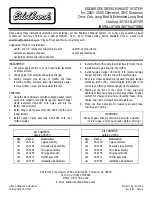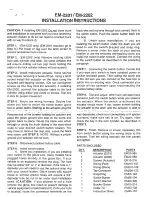
Distance warning function
General notes
The distance warning function can help you to
minimise the risk of a collision with the vehicle in
front or reduce the effects of such a collision. If
the distance warning function detects that there
is a risk of a collision, you will be warned visually
and acoustically.
Important safety notes
i
Observe the "Important safety notes" sec-
tion for driving safety systems (
Y
page 61).
G
WARNING
The distance warning function does not react:
R
to people or animals
R
to oncoming vehicles
R
to crossing traffic
R
when cornering
Thus, the distance warning function cannot
provide a warning in all critical situations.
There is a risk of an accident.
Always pay careful attention to the traffic sit-
uation and be ready to brake.
G
WARNING
The distance warning function cannot always
clearly identify objects and complex traffic
situations.
In such cases, the distance warning function
may:
R
give an unnecessary warning
R
not give a warning
There is a risk of an accident.
Always pay careful attention to the traffic sit-
uation; do not rely on the distance warning
function alone.
Function
The distance warning function issues a warning
at speeds:
R
of approximately 30 km/h or more, if, over
several seconds, the distance maintained to
the vehicle travelling in front is insufficient.
The
·
distance warning lamp then lights
up in the instrument cluster.
R
of approximately 7 km/h or more, if you rap-
idly approach a vehicle in front. An intermit-
tent warning tone will then sound and the
·
distance warning lamp will light up in the
instrument cluster.
X
Brake immediately in order to increase the
distance from the vehicle in front.
or
X
Take evasive action provided it is safe to do
so.
Due to the nature of the system, particularly
complicated but non-critical driving conditions
may also cause the system to display a warning.
With the help of the radar sensor system, the
distance warning function can detect obstacles
that are in the path of your vehicle for an exten-
ded period of time.
Up to a speed of approximately 70 km/h, the
distance warning function can also react to sta-
tionary obstacles, such as stopped or parked
vehicles.
Autonomous braking function
If the driver does not react to the distance warn-
ing signal in a critical situation, COLLISION PRE-
VENTION ASSIST PLUS can assist with the
autonomous braking function.
The autonomous braking function:
R
gives the driver more time to react to critical
driving situations
R
can help the driver to avoid an accident or
R
reduces the effects of an accident
The autonomous braking function is available in
the following speed ranges:
R
from 7 km/h to approximately 105 km/h for
moving objects
R
from 7 km/h to approximately 50 km/h for
stationary objects
Due to the nature of the system, complicated
but non-critical driving conditions may also
cause the autonomous braking function to inter-
vene.
If the autonomous braking function demands
particularly high braking force, preventative
passenger protection measures (PRE-SAFE
®
)
are activated simultaneously.
Driving safety systems
65
Saf
et
y
Z
















































